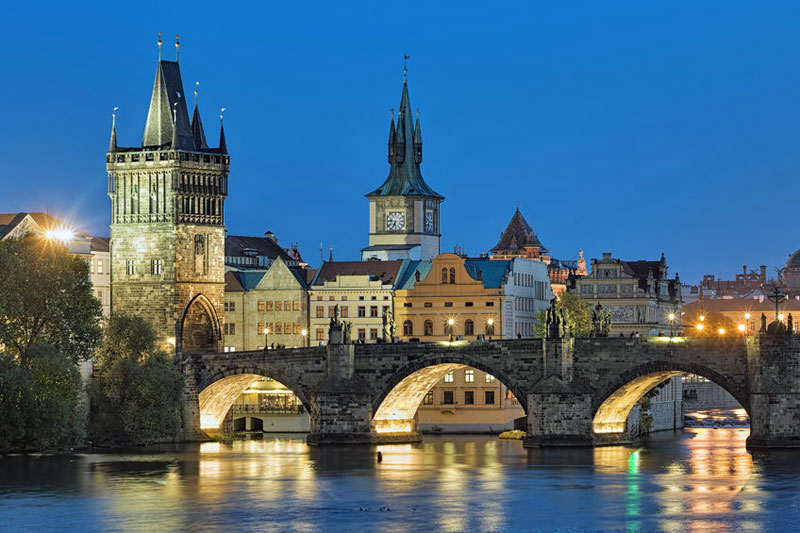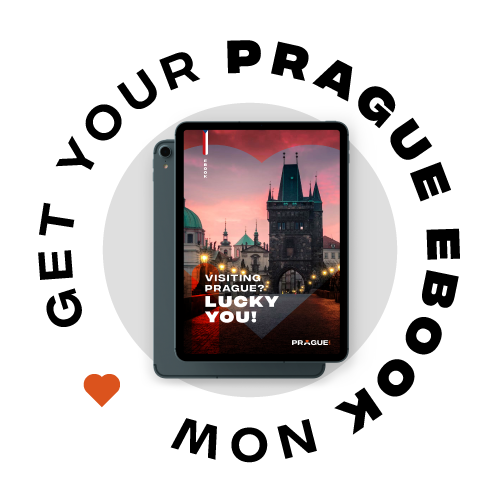Table of contents Show
The Charles Bridge, the most photographed monument of Prague
Czech name: Karlův most
Right in the very heart of Prague is some of the city’s oldest architecture and most iconic and picturesque buildings. Of these, one that tourists most like to visit and photograph is the Charles Bridge. If you plan to visit this city steeped in history and check out Charles Bridge, there is a lot to know before you go.
Where is Charles Bridge Located in Prague & How to Get there
Charles Bridge spans the Vltava River, connecting the castle on one side with most of the original village on the other side. With the exception of trams and lighter modes of transport (e.g., bicycles), cars are not allowed on the bridge because of the age of the bridge and the need to preserve its history. For that reason you can take any tram to Charles Bridge, Prague on the castle side to the bridge. The Lesser Town Square (Malostranské náměstí) tram station is on this side of the bridge. On the opposite side of the river the nearest tram station is Karlovy lázně.
Because of its amazing width and length and how it connects two large sections of this city, you can easily walk to it. Even better, stay in one of the hotels or apartments closest to either end of the bridge. Then you can just take a brisk walk to it whenever it pleases you during your stay.

If you prefer to view the bridge from the river, there are boats that offer water cruises and tours to show you the bridge from a more unique view. The arcade for which this bridge is so well-known allows many boats to pass through underneath with ease every day. It was designed that way to allow merchants and trade ships to come and go from the city with little difficulty.
Opening Hours & Charles Bridge Prague Entrance Fee
Of all the sights to see in this Czech city, this one is the least expensive because it’s free. Even the city’s residents cross over it freely without a second thought. The toll on it has not been collected in over two centuries, making it one of the city’s best sites to see for the budget-conscious traveler.
As for when you can see it, it is open all the time. It is not like any other touristy sort of place in that there are no ropes, no rails, no guards and no restrictions in regards to when you can go and take a walk over this majestic Charles Bridge. The most beautiful time is early in the morning as the sun rises and the fog rolls over and through it, or late in the evening after sunset when the bridge’s lights turn on and make it quite the sight to see.
What to Do & What to See at Charles Bridge Prague
You might be thinking, “It’s just a bridge.” Sure, but there is so much more to the bridge than that. In fact, you should go to see it so that you can enjoy the views both up and down river from the bridge. Go to see the amazing way in which the bridge was constructed six hundred years ago with chiseled sandstone.
Go to see the many statues that decorate the sixteen pillars that support the weight of this massive Charles Bridge. St John of Nepomuk is a prominent figure in Czech history and Catholicism. Legend has it that John was martyred in 1393 when he refused to divulge the queen’s confession to the king. In commemoration of his death, John was canonized in 1729 and is now considered the patron saint of the Czech Republic. Today, St John of Nepomuk is remembered through various religious sites and cultural symbols throughout the country. The most prominent of these is the statue of John on the Charles Bridge in Prague, which is said to bring good luck to those who touch it.
Go to learn the history of the bridge itself, and how it was built on the site of two other bridges. Finally, check out the towers that flank the ends of the bridge, which are all that remains of a former bridge that stood where this bridge now stands.

If that isn’t enough to motivate you to see the Czech Republic’s most famous bridge, consider the “haunted and legendary tour.” This is a must for pursuers of ghost stories and the supernatural. Men were crossed over the bridge to meet their deaths for their crimes, and a ghost-cross where they stopped to pray supposedly appears to those in dire need. Ghosts of people past have been known to tread over the bridge, but not everyone is lucky to see them.
The Prague Signal Festival of Lights is a yearly event that illuminates the historic city of Prague with various light installations, video mappings, and interactive displays. One of the main attractions of the festival is the Charles Bridge, a medieval stone bridge that spans the Vltava River and connects the Old Town with the Lesser Town of Prague. During the festival, the bridge is adorned with colorful light projections that highlight its stunning architecture and history. Visitors can also experience other attractions such as the Prague Castle and Old Town Square that are transformed into magical light shows. The Prague Signal Festival of Lights and its beautiful displays provide a unique and unforgettable way to explore the beautiful city of Prague at night.
History & Charles Bridge Prague Facts
Once upon a time, a bridge of logs helped the Czech people and guests cross to and from over the river. However, the river has a tendency to flood often. As a result, the log bridges that once spanned the distance of the river were frequently washed away.
Another bridge that came to be known as Judith bridge was built in place of the last log bridge in the late 1200’s/early 1300’s. It was made entirely of wood with a stone path. However, another flood in 1342 overwhelmed this bridge too. All that is left of it is the pillars, which are underwater and can only be viewed by diving and with special permission from the Prague government.
The Judith Bridge was several meters to the north of where Charles IV built the current bridge. He realized that continuing to build wooden bridges in the Vltava river was probably not a good idea. Instead, he chose to have this bridge constructed of sandstone blocks, which are sealed with mortar to prevent erosion. It is so well-constructed that it has stood the test of time for almost seven hundred years.
Parts of the older bridges remain. The towers that once belonged to Judith are on both ends of Charles bridge. You can tour the towers as well as the bridge. In fact, most tourists can easily spend two or three hours seeing the bridge and its many related parts from every possible angle before officially claiming that they have seen all there is to see where this magnificent bridge is concerned.
Conclusion
The Charles Bridge in Prague is a historic landmark renowned for its captivating beauty and medieval charm, offering breathtaking views of the city’s picturesque landscape. With our detailed tour guide, you can explore the must-see synagogues in Prague, immersing yourself in their cultural significance and architectural splendor.
The Krizik Fountain in Prague is a mesmerizing display of water, light, and music, providing a captivating experience for spectators. The Charles Bridge in Prague, on the other hand, is an iconic symbol of the city, offering stunning views of the Vltava River and serving as a beloved historical landmark for locals and tourists alike.
When in Prague, don’t miss the opportunity to explore the city’s six must-see art museums, which showcase a diverse range of captivating artworks. For a unique historical perspective, complement your exploration with a visit to the intriguing KGB Museum. Meanwhile, the iconic Charles Bridge provides a picturesque setting to admire stunning views of the Vltava River, creating a perfect backdrop to immerse yourself in the city’s rich history.





